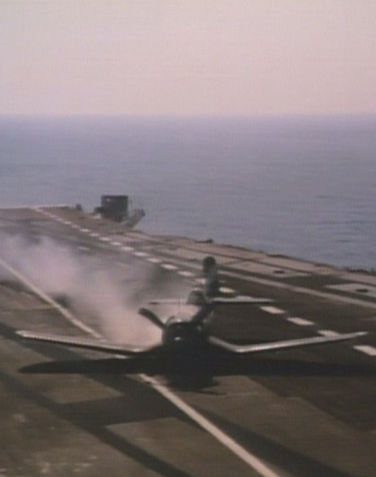Wednesday, May 13, 1992
FLYERS. Written by Arthur Barron, Robin Schiff and Douglas K. Dempsey. Music by Basil Poledouris. Produced and directed by Dennis Earl Moore. Running time: 32 minutes.
THIS YEAR [1992], THE IMAX action is overseas.
IMAX Systems Corporation, ever the innovator in big-screen cinema, has its new films and new formats on view at Spain's Expo 92. Premiering in the Canada Pavilion is its HD (High Definition) process.
Solido, a format for presenting 3-D on a dome screen, is in Japan's Fujitsu Pavilion. Magic Carpet, a process that puts filmgoers on a moving walkway, is part of the French Pavilion.
Here at home, Vancouver's CN IMAX Theatre is marking its fifth anniversary with a less boisterous program. Flyers, new and nostalgic, shares a double bill with Speed, a blast from the past containing a hint of the future.
Built for our own Expo 86, the CN-sponsored cinema premiered Transitions, IMAX's first live-action 3-D film. Reopened May 8, 1987, it is now part of Canada Place. During its first five years, it has had some 20 different programs, including the first feature-length IMAX film, Rolling Stones: At the Max.
Flyers, though new to Vancouver, is from the inventory of IMAX films produced in the early 1980s. Commissioned by the Smithsonian Institution’s National Air and Space Museum, it's a Boy's Own celebration of aviation.
It's also an attempt to present the spectacular IMAX imagery within the context of a fictional story. The title's flyers are pilot Kyle Murphy (Roy Cooper), his brash young protege Tim Johnson (Perry Lang) and Kyle's loyal wife Perk (Margaret Blye).
Kyle and his wingmate have made a life together as husband and wife movie stunt pilots. They plan to recreate for the cameras Kyle's Second World War crash landing on the deck of the aircraft carrier Lexington.
Let's pause for a moment for a quick test. What is your immediate emotional reaction to the following words: F4U Corsair; Nieuport 28; Fokker DR-1 Triplane; Ford Tri-motor?
If your heart suddenly leapt skyward, if names like "Pappy" Boyington, Billy Bishop and the Red Baron came to mind, then Flyers' lack of storytelling sophistication will hardly matter.
The aircraft are here, authentic, in flight and as big as life. It's the romance of man and machine, and for me it was enough.
If your reaction to the above test was a huge ho-hum, you'll not be won over by the film's innocence, wafer-thin plot or performances.
Filling out the bill is Speed. First seen here in 1988, it is more in the direct sensation tradition of IMAX, and it hints at the nature of the next major IMAX improvement.
Speed is the secret of IMAX HD, a format that may be coming soon to Vancouver. Now under consideration at corporate headquarters is a move-over of the Expo 92 production Momentum, the NFB film showcasing the new technology.
The high-definition effect is achieved by doubling projector speed from 24 to 48 frames per second. The result, say reports, is a "super-real" image quality.
The above is a restored version of a Province review by Michael Walsh originally published in 1992. For additional information on this archived material, please visit my FAQ.
Afterword: The “quick test” in the above review featured the names of four aircraft and three legendary fighter pilots. The Fokker DR-1 Triplane was notable for having been flown by Germany’s Red Baron, Manfred von Richthofen. Canada’s William Avery “Billy” Bishop made his name in a Nieuport 17, while the later model 28 of the French fighter was the weapon of choice for American ace Eddie Rickenbacker. The Ford Tri-motor was a familiar sight in aviation movies of the 1930s, while the F4U Corsair was a dogfighter in the Pacific during the Second World War. Marine pilot Gregory "Pappy" Boyington, celebrated for his derring-do at the controls, was among those who romanticized aerial warfare.
Yes, war is hell, never more so than in the 20th century when industrial weaponry combined with inept leadership turned battlefields into human abattoirs. Even so, in the aftermath of the First World War there were those who insisted on following the advice offered in Monty Python’s Life of Brian to “always look on the bright side of life.” After all, the 20th century was also the age of flight, when mankind was suddenly able to take to the heavens. Rather than obsess on the insane carnage below, the popular culture concentrated on the return of knightly combat, telling the stories of brave individuals facing one another high above, the Captains of the Clouds, as one 1942 movie had it.
Director Dennis Earl Moore's Flyers spoke to that tradition with its tale of movie stunt performers. It was filmed in the IMAX 70mm process at a time when such pictures were specialty items shown in custom venues, such as world’s fairs or tourist destinations. Flyers made its debut in the Smithsonian Institution’s National Air and Space Museum, doing so four years before the 1986 release of Top Gun. The stories are connected because the current Top Gun: Maverick, released two days ago (May 27), was shot using the company’s newest big screen cameras. If the rapturous reviews are to be believed, seeing the picture in an IMAX-equipped theatre makes a significant difference to the viewing experience.
